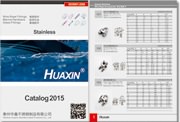 Home >Safety Instructions
Home >Safety Instructions COMPANY INFOMATION
- Company Profile
- History
- Quality Control
- Customize
- Precision Casting
- Metal Stamping
- Wire Rope Assembly
- Machining
- Equipment
- Service
- Message
- Contact Us
※ Please be aware that there may be deviation and tolerance in noted measurements.
※ The breaking load is approximate, and will change depending on usage situation and environment. In addition, in the event test data is required, please make a separate request, and extra cost will be generated.
※ Specifications may change without prior notification.
※ Photos could show our products very clearly, but there may be a little difference in style because of different specifications.
※ Please do not copy and reproduce the contents of our website without any express permission.
Safety Instructions
IMPORTANT SAFETY WARNINGS
It is of the utmost importance that anyone purchasing from this website read and understand all warnings and other information listed below and/or adjacent to the product description.
All products are sold with the express understanding that the purchaser is thoroughly familiar with the correct application and safe use. Use all products properly, in a safe manner and for the application for which they were intended. Huaxin Stainless assumes no responsibility for the use or misapplication of any product sold. Responsibility for design and use decisions rests with the user.
REMEMBER: Any product will break if abused, misused or overused. Any well-designed and well-built product can become hazardous in the hands of a careless user.
It would be impossible in the text of this website to list all possible dangers and misapplications associated with the use of all products contained herein. However, in order to promote safe rigging habits, the most common hazards associated with the use of these products are outlined. Therefore:
> Never exceed the Work Load Limit.
> Match components properly.
> Keep out from under a raised load.
> Avoid shock loads.
> Inspect products regularly.
WORK LOAD LIMIT
Never exceed the Work Load Limit (WLL) Rated Capacity. The Work Load LImit is the maximum load which should ever be applied to the product, even when the product is new and when the load is uniformly applied – straight line pull only. Avoid side loading. All web-site catalog ratings are based upon usual environmental conditions, and consideration must be given to unusual conditions such as extreme high or low temperatures, chemical solutions or vapors, prolonged immersion in salt water, etc. Such conditions or high-risk applications may necessitate reducing the Work Load Limit. Work Load Limit will not apply if product has been welded or otherwise modified.
MATCHING OF COMPONENTS
Components must match. Make certain that components such as hooks, links or shackles, etc. used with wire rope (or chain or cordage) are of suitable material and strength to provide adequate safety protection. Attachments must be properly installed and must have a Work Load Limit at least equal to the product with which they are used.
RAISED LOADS
Keep out from under a raised load. Take notice of the recommendation from the National Safety Council Accident Prevention Manual concerning all lifting operations:
"All employees working on cranes or hoists or assisting in hooking or arranging a load should be instructed to keep out from under the load. From a safely standpoint, one factor is paramount. Conduct all lifting operations in such a manner, that if there were an equipment failure, no personnel would be injured. This means keep out from under a raised load and keep out of the line of force of any load."
SHOCK LOADS
Avoid impacting, jerking or swinging of load -- Work Load Limit will not apply. A shock load is generally significantly greater than the static load. Avoid shock loads.
REGULAR INSPECTIONS
Inspect products regularly for visible damage, cracks, wear, elongation, rust, etc. Protect all products from corrosion. The need for periodic inspections cannot be overemphasized. No product can keep operating at rated capacity indefinitely. Periodic inspections help determine when to replace a product and reduce rigging hazards. Keep inspection records to help pinpoint problems and to insure periodic inspection intervals.
Due to the diversity of the products involved and uses to which they can be put, it would be counter-productive to make blanket recommendations for inspection procedures and frequency. Best results will be achieved when qualified personnel base their decisions on information from rigging and engineering manuals and on experience from actual use in the field. Refer to sources listed below for technical literature.
Frequency of inspection will depend on environmental conditions, application, storage of product prior to use, frequency of use, whether or not life, limb or valuable property are at risk, etc. When in doubt, inspect product prior to each use. Carefully check each item to be inspected for wear, deformation, cracks or elongation-signs of imminent failure. Immediately withdraw such items from service.
Rust damage is another potential hazard. When in doubt about the extent of corrosion or other damage, withdraw the items from service. Destroy, rather than discard, items that have been judged defective. They might be used again by someone not aware of the hazard of the defect.
DEFINITIONS
Information contained in this catalog is subject to change; all weights and dimensions are approximate. Ratings are stated in short tons (2,000 lbs.) or pounds. All dimensions are in inches; all weights are in pounds.
PROOF TEST LOAD
The term "Proof Test" designates a quality control test applied to the product for the sole purpose of detecting defects in material or manufacture. The Proof Test Load (usually twice the Work Load Limit) is the load which product withstood without deformation when new and under laboratory test conditions. A constantly increasing force is applied in direct line to the product at a uniform rate of speed on a standard pull testing machine.
BREAKING STRENGTH/ULTIMATE STRENGTH
Do not use breaking strengths as a criterion for service or design purposes. Refer to the Work Load Limit.
Breaking Strength is the average force at which the product, in the condition it would leave the factory, has been found by representative testing to break, when a constantly increasing force is applied in direct line to the product at a uniform rate of speed on a standard pull-testing machine.
REMEMBER: Breaking Strengths, when published, were obtained under laboratory conditions that are almost always impossible to duplicate in actual use.
Design Factor (sometimes referred to as safety factor) An industry term denoting theoretical reserve capability. Usually computed by dividing the catalog Breaking Strength by the catalog Work Load Limit and generally expressed as a ratio. For example: 5 to 1.
 +86 523 83789258
+86 523 83789258 info@tzhuaxin.com
info@tzhuaxin.com















 HuaxinCatalog Download
HuaxinCatalog Download


